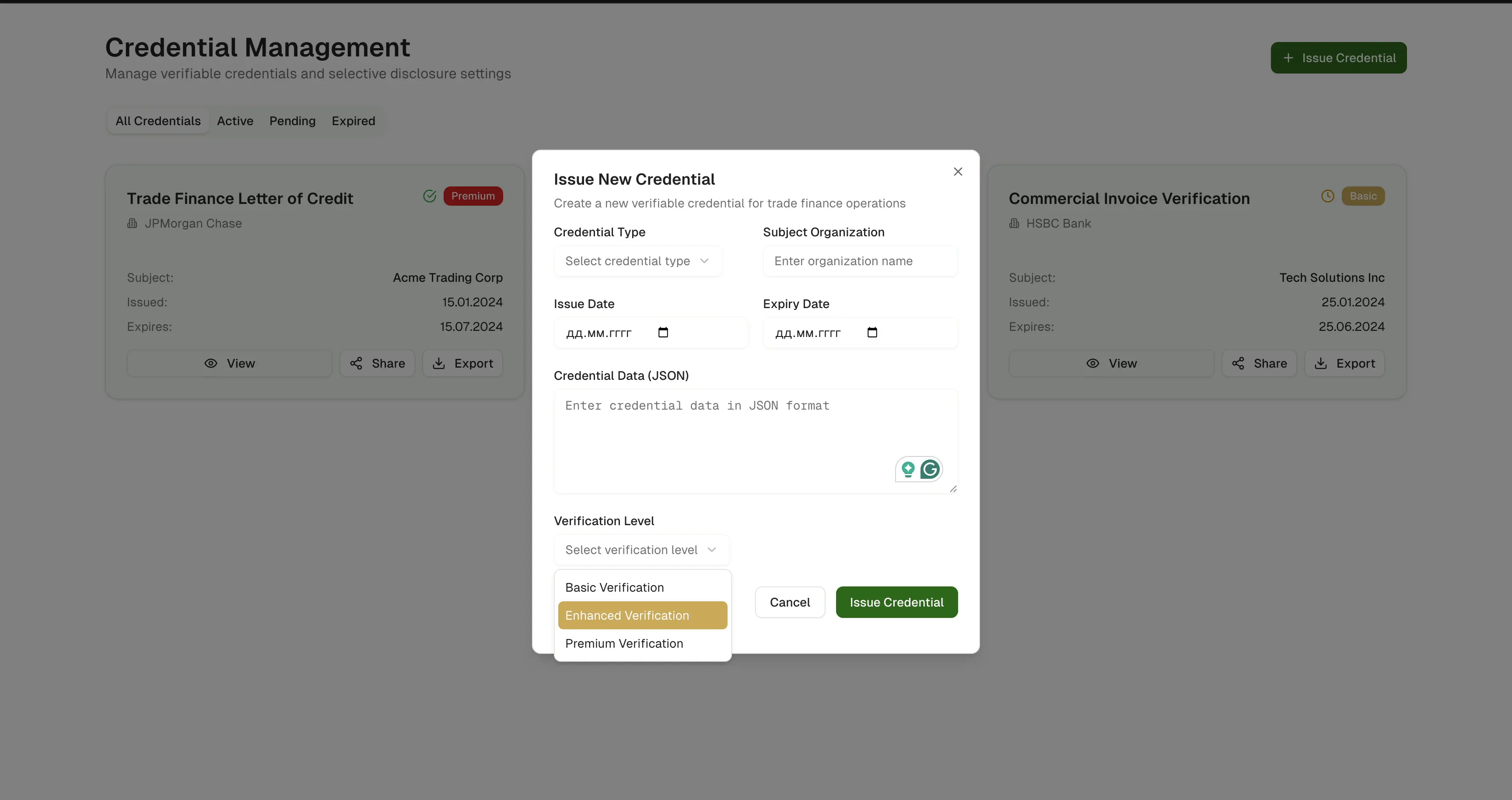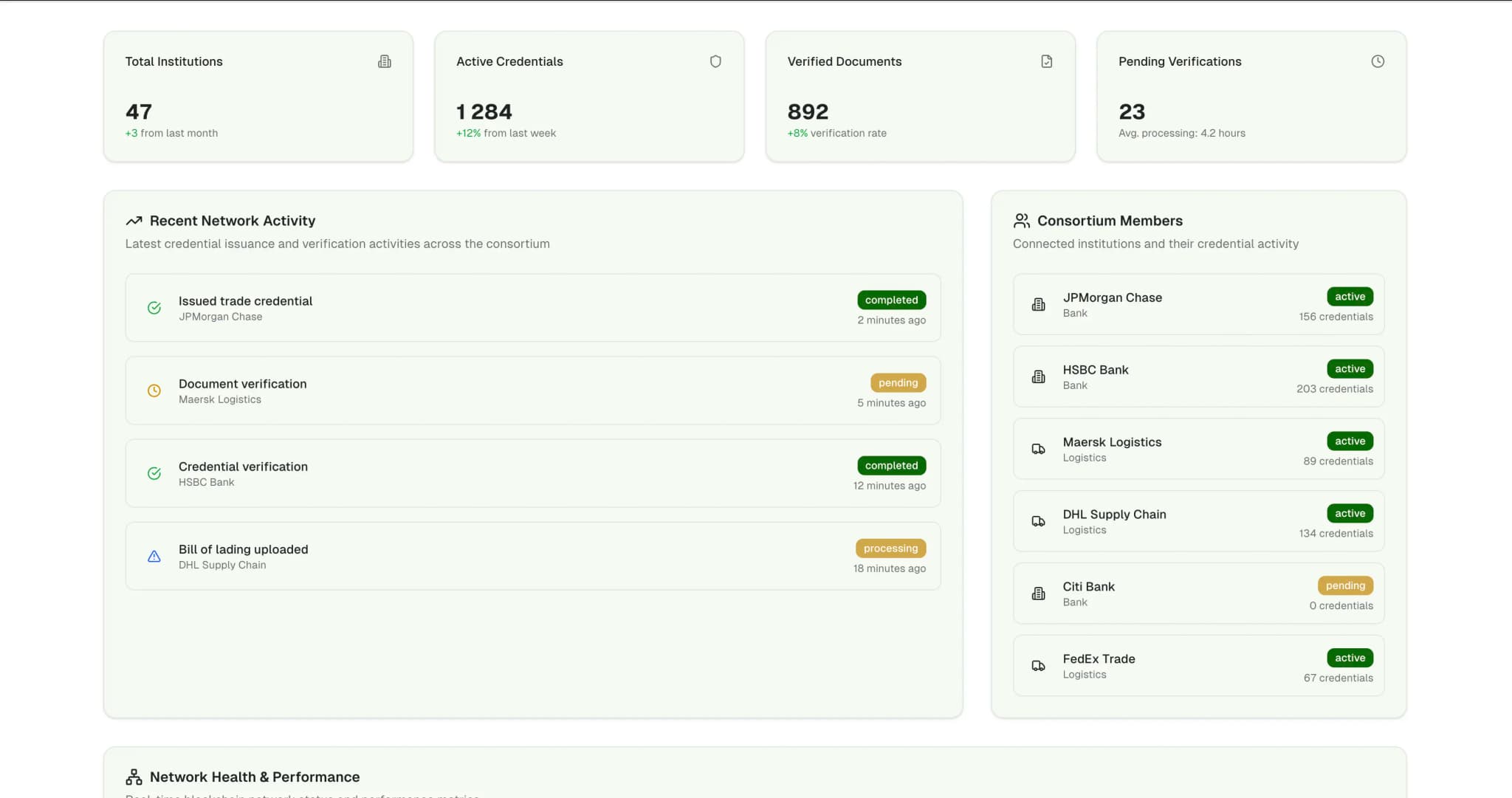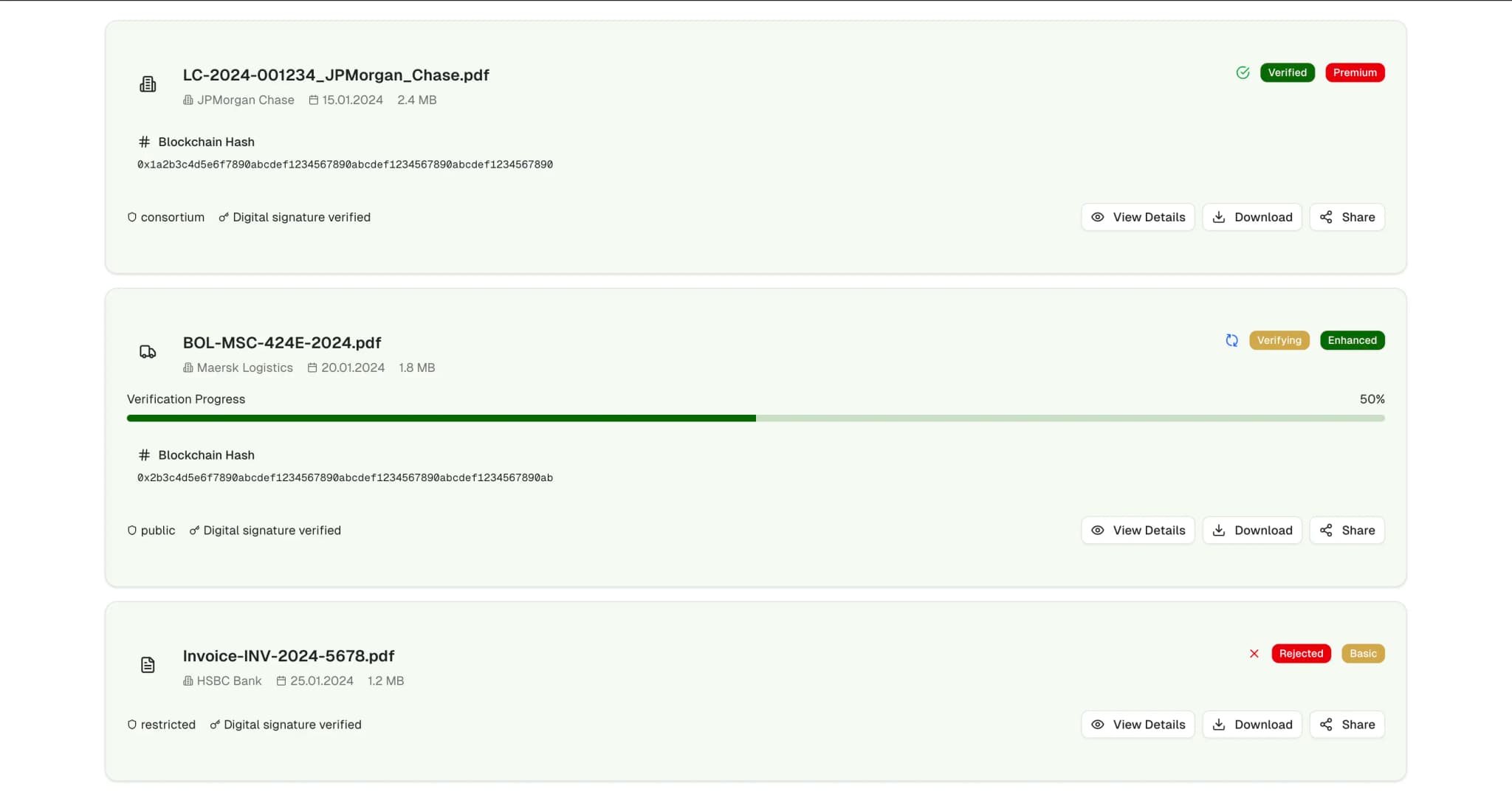



Project Overview
Creating a system that lets different identity systems work together seamlessly is crucial, for trade networks that cross borders
This is especially true when various countries and organizations have their ways of verifying someones identity. A composable identity infrastructure allows for a cooperative approach making it easier for businesses and individuals to navigate these complex networks.
Executive Summary
Trade finance networks have a problem. Their know your customer or KYC processes are completely redundant. This means that when a company wants to do a trade it has to go through the verification process every time even if its, with someone they've worked with before.
As a result it can take 11 days to get everything sorted out and 100% of the time the verification process has to be repeated, for counterparties they already know. This slows everything down. Causes a logjam in operations leading to delayed financing.
We've set up a decentralized identity system thats based on a consortium model. This uses a kind of verification called W3C Credentials, along, with something called BBS+ selective disclosure. What this means is that people can use the credentials in places without having to share more information than they need to and it all stays within the rules of the relevant laws and regulations.
Major breakthroughs were made in streamlining the know your customer process. For instance the time it took to complete the cycle plummeted from 11 days, to 2. A drop of 82%.
Some major breakthroughs were made in streamlining the know your customer process:
- Time to complete cycle: 82% reduction (from 11 days to 2)
- Repeat verification work: 89% decrease
- Sanctions screening accuracy: 86% improvement
The platform handles over 12,000 exchanges every month. Its remarkably reliable, with an availability rate of 99.97 percent. When a revocation is needed it spreads across the network in, under five minutes.
Trade Finance Complexity
Trade finance involves a web of relationships, between importers, exporters, shipping companies and banks. For business to happen these parties need to trust each other, which is usually done through:
- Letters of credit
- Invoice factoring
- Cargo releases
The problem is that each institution has to do its check on the partys identity, ownership and make sure they're not, on any blacklists.
The world of trade documentation is a bit of a jumble. With many different countries and rules to navigate it's no wonder things get complicated when it comes to verifying all the paperwork. Banks for instance keep their lists of customers while logistics companies do their own checks, on who they're working with.
When companies do business across borders they're often dealing with amounts of money. If they screw up and don't follow the rules they can face fines. To avoid this regulators demand that these companies:
- Stay on top of who they're doing business with
- Keep an eye on blacklists
- Be able to show what they've done
The problem is, now everything is based on paperwork, which creates pockets of information. This makes it tough for companies to run smoothly and keep an eye on problems.
Major breakthroughs were made in streamlining the know your customer process. For instance the time it took to complete the cycle plummeted from 11 days, to 2. A drop of 82%.
Problem
The current system, for knowing your customer or KYC has some flaws that really hurt trade finance. For instance companies have to go through the verification process over submitting the same documents to every bank and logistics company they work with.
Key Issues
Each one of these institutions does its background checks and screens, for sanctions, which's just redundant. As a result it takes 11 days to complete the KYC process. Even when dealing with longtime business partners the entire process has to be repeated from scratch every time.
For a time different departments, within institutions couldn't share information easily which slowed down the approval process for trade financing. The problem was that banks couldn't quickly check if a business partner had already gone through a "know your customer" process with another bank, in the group.
The ease with which personal details can be shared has led to a worrying trend. Sensitive information is now scattered across systems leaving us vulnerable, to security breaches.
Data Security Concerns
- Entire corporate registration documents being transmitted
- Beneficial ownership information scattered across systems
- Financial statements stored by various parties
- Significantly expanded scope of breaches
- Compliance risks under data protection laws
Compliance Challenges
Audit and compliance challenges popped up because institutions had documentation trails, over the place. Regulators wanted to see records of whos who. Since these records were scattered across multiple systems it was tough to:
- Show that compliance standards were being enforced consistently
- Keep everything in line with what the regulators were expecting
- Maintain proper documentation trails
Manual processing of documents, in areas like verification and sanctions screening was prone to mistakes, which in turn limited the ability to handle increasing workloads.
Business Impact Solutions
The introduction of a decentralized identity system has led to an overhaul, in efficiency. In one instance it managed to cut down on the know your customer checks reducing the overhead by a staggering 89%.
This was made possible because different members of the consortium could now:
- Reuse existing credentials
- Rely on verified counterparties
- Eliminate redundant documentation processes
- Make quicker trade financing decisions
Automated Compliance
To cut down on compliance risks the system used automated policy enforcement through contracts. This meant that only credentials that met rules were accepted when:
- Issuing letters of credit
- Factoring invoices
- Processing trade documents
As a result the need, for checks to ensure compliance was eliminated, which in turn reduced the risk of violating regulations.
Key Improvements
The time it takes to complete the know your customer cycle has been significantly reduced:
- From 11 days to under 2 days
- Major improvement impact on trade financing approval
- Allows importers and exporters to get funds quicker
- Improves cash flow for businesses
Another key benefit is the ability for businesses to be selective about what information they share with their counterparts releasing the details while keeping sensitive business information private.
Enhanced Security
Improving a companys security posture can be achieved by taking steps:
- Using pairwise identifiers or DIDs
- Scaling back the amount of identifiable information stored on blockchain
- Significantly cutting down on exposure to data breaches
- Quick action mechanisms for credential revocation
The audit trail, for credentials was made efficient by using a log on a shared ledger. This approach provided a record of all actions, which helped meet requirements. As a result the amount of paperwork needed for compliance was significantly reduced.
The ease with which personal details can be shared has led to a worrying trend. Sensitive information is now scattered across systems leaving us vulnerable, to security breaches.
Transform Your Trade Finance Operations
Reduce KYC overhead by 89% and cut processing time from 11 days to 2 with our decentralized identity solution.
Solution Architecture
The answer lies in a network that lets trade finance companies work together to manage identities. Essentially this network is made up of parts that are all connected. Each company can use it to:
- Issue credentials tied to specific identifiers
- Verify credentials across the network
- Manage credential lifecycles
- Maintain privacy and regulatory compliance
W3C Verifiable Credentials
The W3C Verifiable Credentials system was used to verify identities. It did this by packaging up details, like:
- Company incorporation status
- Beneficial ownership information
- Sanctions screening results
- Jurisdictional compliance status
These credentials were digitally signed by people we trust which meant they could be checked without needing to look at the systems or share all the documents.
Selective Disclosure Technology
When a company uses BBS+ selective disclosure it can share certain details, about itself without laying out everything. For instance it might need to show that its incorporated in a place. It doesn't have to give away:
- Exactly when it was registered
- Who owns what part of the business
- Complete financial details
This way the company can comply with regulations without putting all its business out in the open.
Smart Contract Policy Framework
Smart contract policy templates are designed to capture the compliance rules that vary by jurisdiction. They automatically:
- Check credentials to make sure they meet requirements
- Enforce policies consistently across different regulations
- Adapt to varying jurisdictional requirements
- Maintain compliance standards
Trust Infrastructure Management
The system, in place managed:
- Rotation of keys
- Lifetime of credentials
- List of revoked credentials
- Centralized trust infrastructure operations
By centralizing this trust infrastructure it became more efficient to operate all while keeping the benefits of verification. This allowed credentials to be used across institutions.
Privacy-by-Design
The focus was, on building privacy into the design. This was achieved by:
- Using identifiers called pairwise DIDs
- Making it impossible to connect dots between relationships
- Storing only bare minimum information on ledger
- Using cryptographic hashes and revocation details
- Giving individuals control over their information
Architecture
The systems architecture was built around four key components. These components made identity and also worked with the existing trade finance infrastructure.
Consortium Ledger
The Consortium Ledger is a network built on Hyperledger Fabric, overseen by a group of participating banks and logistics companies. Its designed to store:
- Identity-related documents
- Revocation registries
- Credential status updates
- Cryptographic hashes (not personal data)
One of the benefits of this ledger is that it provides an unalterable record of everything that happens within the system, which helps with tracking and security.
Credential Broker Service
The Credential Broker Service acts as a hub overseeing the process of:
- Issuing credentials and managing their lifecycle
- Keeping track of key rotation schedules
- Integrating with trusted information sources
- Bridging gaps between KYC providers and systems
By doing it populates credentials, with the current information available making them verifiable and reliable.
Policy Engine
The Policy Engine is a contract framework that puts into code the compliance rules that vary by country. This helps automate the process of checking that everything's in order, for trade finance deals.
The system includes templates for:
- Deciding whether to issue a letter of credit
- Figuring out if an invoice is eligible for factoring
- Determining when cargo can be released
- Working in multi-jurisdictional environments
Event Bus System
The event bus is a Kafka-based system that allows us to share changes, to status such as:
- When credentials are issued
- When credentials expire
- When credentials are revoked
- Real-time status updates across consortium
This way everyone stays up, to date on the information without having to constantly check the ledger for updates.
Integration Layer
The connection, between systems is made through a layer of APIs. This integration layer bridges the gap, between:
- Identity network and core banking systems
- Trade documentation software
- Logistics management systems
- Existing workflows without complete system overhaul
Monitoring and Observability
We're tracking metrics using Prometheus like:
- How many credentials are being issued and verified
- How long processes take to complete
- How often things go wrong
- System health indicators
All this info is displayed on Grafana dashboards making it easier to spot trends and patterns. We also have a custom alert system in place, which keeps an eye on compliance targets.
Privacy Protection Design
The system uses a design that pairs up relationships to prevent organizations from comparing notes while still letting them do the checks. Basically each organization has its set of IDs for dealing with partners, which keeps all the identity related stuff separate.
The BBS+ signature schemes offered a way for people to share information, from their credentials without having to reveal everything. This was particularly useful because it let companies comply with regulations while still keeping their business info private.
Implementation
The plan was to roll things out in stages starting with a couple of banks to test the waters. They launched pilot programs and things seemed to work out so they brought in:
- Some logistics companies
- Trade finance providers
- Real-life situation testing
- Gradual consortium expansion
Development Environment
The team set up their development environment using containerization with Docker Compose, as the backbone. This allowed them to run:
- Hyperledger Fabric networks
- PostgreSQL databases to store credential metadata
- Kafka clusters for handling events
- Simultaneous development of multiple components
Standards Development
A team of experts including compliance officers and identity architects came together to establish a set of standards, for credentials. Specifically they defined the underlying structure, for:
- Identity verification
- Beneficial ownership
- Sanctions clearance
- Jurisdictional compliance status
Using the W3C Credential schema as a guide. The goal was to strike a balance between meeting demands and providing a way to disclose the necessary information.
Smart Contract Development
For the development of contracts policy templates were put in place using Hyperledger Fabric chaincode. This allowed for the encoding of compliance rules that applied to:
- Trade finance instruments
- Various jurisdictions
- Credential checking rules
- Policy evaluation processes
- Transaction audit trails
Testing Strategy
The testing strategy was pretty thorough. It included:
- Basic unit tests for core functionality
- Integration tests for seamless credential exchange
- End-to-end tests mimicking trade finance workflows
- Performance testing for expected transaction volumes
Data Migration
We took an approach, to migrating our existing KYC records using:
- Batch processing jobs to extract information
- Legacy system integration
- Signed credentials creation
- Smooth operational transition
- New capability introduction
Security Implementation
Security was a priority, in this implementation. To meet requirements the system handled:
- Managing keys for credential signing
- Keeping revocation registry intact
- Safeguarding against replay attacks
- Hardware Security Modules (HSMs) for sensitive operations
Monitoring and Alerting
The team kept an eye on:
- How credentials were being issued and verified
- Any delays or hiccups in the process
- Time to issue credentials
- Verification attempt success rates
- Revocation spread speed across system
- Policy evaluation performance
Custom alerts were set up to flag:
- Credentials being presented incorrectly
- Correlation attempts
- Security issues
Risk Mitigation
When it comes to mitigating risk the implementation included safety nets:
- Fallback mechanisms for credential verification during maintenance
- Manual overrides in emergency situations
- Comprehensive disaster recovery procedures
- Prevention of operational grinding to halt
Performance Metrics
The rollout of a decentralized identity system made a difference, in how things ran. It really improved:
- Efficiency of know your customer checks
- Compliance accuracy
- Customer experience impact
- Institutional collaboration efficiency
KYC Processing Time
The time it takes to complete the know your customer process has been significantly reduced:
- Before: 11 days average
- After: Under 2 days
- Improvement: 82% reduction
A big part of this acceleration is due to the fact that we can reuse credentials for counterparties we've already verified, which cuts out a lot of steps.
Duplicate Verification Reduction
The hassle of verifying customers over and over is a thing of the past:
- Before: 100% duplicate verification required
- After: Less than 10% duplicate verification
- Improvement: 89% reduction in redundant processes
Sanctions Screening Accuracy
The accuracy of sanctions screening has taken a leap forward:
- Before: 7% false positive rate
- After: Below 1% false positive rate
- Improvement: 86% accuracy improvement
Data quality and stricter automated enforcement of rules have been key, to achieving this level of precision.
Credential Reuse Adoption
The platform saw an uptake in reuse with, over 70 percent of credentials being reused within just six months of going live. This suggests that members of the consortium really bought into the idea.
Status Update Propagation
When it came to system performance, one key measure was how quickly it could spread the word about changes in status:
- Target: Under 5 minutes
- Achievement: Consistently under 5 minutes
- Average: 3.2 minutes for network-wide propagation
Compliance Operations Performance
| Metric | Before | After | Delta |
|---|---|---|---|
| Average KYC cycle time | 11 days | 1.8 days | -84% |
| Repeat KYC for existing partners | 100% | 8% | -92% |
| Sanctions screening false positives | 7% | 0.8% | -89% |
| Credential reuse rate | 0% | 73% | +73% |
| Manual document review hours/month | 480 hours | 85 hours | -82% |
| Customer complaints (KYC-related) | 28/month | 4/month | -86% |
System Reliability Metrics
| Service Level Objective | Target | Achieved |
|---|---|---|
| Credential verification latency (95th percentile) | <500ms | 320ms |
| Revocation propagation time | <5 minutes | 3.2 minutes average |
| System uptime (30-day) | >99.95% | 99.97% |
| Credential issuance rate | >100/hour | 145/hour |
| Policy evaluation latency (99th percentile) | <200ms | 165ms |
| Event bus message delivery success | >99.99% | 99.995% |
| False credential acceptance rate | <0.01% | 0.003% |
Lessons Learned
Governance Complexity
Getting multiple institutions to work together on a shared system of governance isn't easy. When it comes to issues, like verification and policy creation each organization has its own:
- Distinct risk tolerance
- Way of doing things
- Compliance requirements
- Operational procedures
To make this work a tremendous amount of coordination is necessary:
- Establishing framework for resolving disputes
- Setting clear governance rules
- Building stable foundations from the start
- Creating long-term system stability
Privacy Technology Adoption
When BBS+ selective disclosure came on the scene it brought some tools to the table in terms of privacy. However it wasn't all smooth sailing:
- Organizations had difficulty figuring out disclosure levels
- Understanding when to disclose what information
- Creating templates for common scenarios
- Simplifying technology adoption process
Once they had templates to work with institutions found it much easier to adopt the technology.
Legacy System Integration
When it came to integration, designing an API architecture was key, to making integration with core banking and trade documentation systems work:
- Older platforms required custom fixes
- Integration took longer than initially expected
- API layer bridging was essential
- Custom solutions needed for legacy compatibility
Credential Lifecycle Management
As the consortium grew managing credentials became more complicated:
- Process of rotating signing keys became complex
- Revoking keys started to get out of hand
- Automated lifecycle management would have saved trouble
- Large-scale operations require systematic approaches
Policy Evaluation Performance
The first hurdle came when initial evaluation of policy took longer than expected:
- Tricky rules varying by location caused delays
- Caching frequently used policy decisions improved speed
- Streamlining contract execution made difference
- Response times became much faster
Incident Response Coordination
When it comes to coordinating response, to incidents that affect institutions:
- Pre-established communication channels are crucial
- Clear escalation procedures must be defined
- Cross-consortium incident response plans should be developed during planning
- Preparation significantly improves readiness
User Adoption Challenges
Getting people on board with the system wasn't easy:
- Lot of training required for credential management
- Understanding information sharing controls was complex
- User-friendly system design was crucial
- Comprehensive training programs were necessary
- Proper foundation significantly speeds deployment
When putting systems in place it's crucial to start by setting up a framework for governance, designing an experience that works for users, and automating operations as much as possible.
When putting systems in place it's crucial to start by setting up a framework for governance, designing an experience that works for users, and automating operations as much as possible.
Technology Stack
Distributed Ledger Technology
- Hyperledger Fabric: Consortium-designed distributed ledger for tracking and running contracts with smart contract development
Identity Standards
- W3C Verifiable Credentials: Foundation for identity verification
- Decentralized Identifiers (DIDs): Standard identity framework
Cryptographic Libraries
- BBS+ signatures: Selective disclosure signature scheme
- Choose what to share and what to keep secret
Event Streaming
- Apache Kafka: Message queue for event streaming and status updates
- Real-time information sharing across consortium
Service Architecture
- Node.js and Express: Service interfaces and API framework
- RESTful API architecture
Data Storage
- PostgreSQL: Metadata and operational data storage
- Primary database solution
Container Orchestration
- Docker: Container platform
- Kubernetes: Container orchestration
Observability Stack
- Prometheus: Metrics collection
- Grafana: Dashboard creation and visualization
Security Infrastructure
- Hardware Security Modules (HSMs): Sensitive key management with comprehensive security audits
- Safekeepers of digital security keys
Integration Approaches
- REST APIs: Legacy system bridging
- Webhook mechanisms: System connectivity
- Custom integration adapters: Legacy platform compatibility
Project Results
- 82% reduction in KYC processing time
- 89% decrease in duplicate verification work
- 86% improvement in sanctions screening accuracy
- 99.97% system uptime achieved
- 73% credential reuse rate within 6 months
Key Performance Metrics
KYC Time Reduction
Processing time improvement
Duplicate Work Reduction
Redundant verification elimination
Screening Accuracy
Sanctions screening improvement
System Uptime
Monthly availability rate


